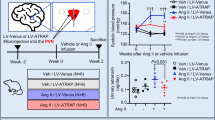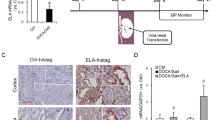Abstract
The aim of this study was to determine the effect of RNA interference inhibition of mineralocorticoid receptor (MR) on cold-induced hypertension (CIH) and renal damage. Recombinant adeno-associated virus (AAV) carrying short hairpin small interference (si)RNA for MR (AAV.MR-shRNA) was constructed and tested for the ability to inhibit renal MR and to control CIH. Three groups of rats with CIH received AAV.MR-shRNA (1.25 × 109 particles/rat, intravenous), AAV carrying scrambled shRNA (AAV.Control-shRNA) (1.25 × 109 particles/rat, intravenous) and phosphate buffer solution (PBS), respectively. All rats were kept in a cold chamber (6.7°C) throughout the experiment. Adeno-associated virus delivery of MR-shRNA prevented progression of CIH. Blood pressure (BP) of the AAV.MR-shRNA-treated group did not increase and remained at 145±3 mm Hg, whereas BP of the AAV.Control-shRNA-treated and PBS-treated group increased to 167±4 and 161±3 mm Hg, respectively, at 3 weeks after gene delivery. Thus, the antihypertensive effect of a single injection of AAV.MR-shRNA lasted for at least 3 weeks (length of the study). Adeno-associated virus carrying short hairpin siRNA for MR significantly increased urinary sodium excretion and decreased proteinuria. It also decreased serum creatinine and blood urea nitrogen, suggesting enhanced renal function. Both Western blot and immunohistochemical analysis showed that MR expression was decreased significantly in the kidney in the AAV.MR-shRNA-treated rats, confirming that renal MR is effectively inhibited by AAV.MR-shRNA. Adeno-associated virus carrying short hairpin siRNA for MR also significantly attenuated renal hypertrophy. In addition, AAV delivery of MR-shRNA prevented atrophy and dilation of renal tubules and abolished tubular deposition of proteinaceous material seen in CIH rats. Conclusions: (1) AAV delivery of MR-shRNA effectively silenced MR in vivo. (2) RNA interference inhibition of MR may open a new avenue for the long-term control of hypertension and renal damage.
This is a preview of subscription content, access via your institution
Access options
Subscribe to this journal
Receive 12 print issues and online access
$259.00 per year
only $21.58 per issue
Buy this article
- Purchase on Springer Link
- Instant access to full article PDF
Prices may be subject to local taxes which are calculated during checkout








Similar content being viewed by others
References
White WB, Duprez D, St Hillaire R, Krause S, Roniker B, Kuse-Hamilton J et al. Effects of the selective aldosterone blocker eplerenone versus the calcium antagonist amlodipine in systolic hypertension. Hypertension 2003; 41: 1021–1026.
Flack JM, Oparil S, Pratt JH, Roniker B, Garthwaite S, Kleiman JH et al. Efficacy and tolerability of eplerenone and losartan in hypertensive black and white patients. J Am Coll Cardiol 2003; 41: 1148–1151.
Park JB, Schiffrin EL . Cardiac and vascular fibrosis and hypertrophy in aldosterone-infused rats: role of endothelin-1. Am J Hypertens 2002; 15: 164–169.
Sun Y, Zhang J, Lu L, Chen SS, Quinn MT, Weber KT . Aldosterone-induced inflammation in the rat heart: role of oxidative stress. Am J Pathol 2002; 161: 1773–1781.
Lacolley P, Labat C, Pujol A, Delcayre C, Benetos A, Safar M . Increased carotid wall elastic modulus and fibronectin in aldosterone-salt-tretaed rats: effects of eplerenone. Circulation 2002; 106: 2848–2853.
Virdis A, Neves MF, Amiri F, Viel E, Touyz RM, Schiffrin EL . Spironolactone improves angiotensin-induced vascular damage and oxidative stress. Hypertension 2002; 40: 504–510.
Pu Q, Neves MF, Virdis A, Touyz RM, Schiffrin EL . Endothelin antagonism on aldosterone-induced oxidative stress and vascular remodeling. Hypertension 2003; 42: 49–55.
Endemann DH, Touyz RM, Iglarz M, Savoia C, Schiffrin EL . Eplerenone prevents salt-induced vascular remodeling and cardiac fibrosis in stroke-prone spontaneously hypertensive rats. Hypertension 2004; 43: 1252–1257.
Micromedex, Inc. Eplerenone Drug Evaluation. Monograph, Vol 114, 1972–1974 (Exp. 12/12/2002).
Gyllerup S, Lnke J, Lindholm LH, Schersten B . Cold climate is an important factor in explaining regional differences in coronary mortality even if serum cholesterol and other established risk factors are taken into account. Scott Med J 1993; 38: 169–172.
Donaldson GC, Robinson D, Allaway SL . An analysis of arterial disease mortality and BUPA health screening data in men, in relation to outdoor temperature. Clin Sci Colch 1997; 92: 261–268.
Caicoya M, Rodriguez T, Lasheras C, Cuello R, Corrales C, Blazquez T . Stroke incidence in Asturias, 1990–1991. Rev Neurol 1996; 24: 806–811.
Marchant B, Ranjadayalan K, Stevenson R, Wilkinson P, Timmis AD . Circadian and seasonal factors in the pathogenesis of acute myocardial infarction: the influence of environmental temperature. Br Heart J 1993; 69: 385–387.
Minami J, Kawano Y, Ishimitsu T, Yoshimi H, Takisita S . Seasonal variations in office, home and 24 h ambulatory blood pressure in patients with essential hypertension. J Hypertens 1996; 14: 1421–1425.
Sheth T, Nair C, Muller J, Yusuf S . Increased winter mortality from acute myocardial infarction and stroke: the effect of age. J Am Coll Cardiol 1999; 33: 1916–1919.
Thorvaldsen P, Asplund K, Kuulasmma AM, Schroll M . Stroke incidence, case fatality, and mortality in the WHO MONICA project: World Health Organization Monitoring Trends and determinants in cardiovascular diseases. Stroke 1995; 26: 361–367.
Baker-Blocker A . Winter weather and cardiovascular mortality in Minneapolis-St. Paul. Am J Public Health 1982; 72: 261–265.
Seretakis D, Lagiou P, Lipworth L, Signorello LB, Rothman KJ, Trichopoulos D . Changing seasonality of mortality from coronary heart disease. JAMA 1997; 278: 1012–1014.
Hata T, Ogihara T, Maruyama H, Mikami H, Nakamaru M, Naka T et al. The seasonal variation of blood pressure in patients with essential hypertension. Clin Exp Theory and Pract 1982; A4: 341–354.
Verdon F, Boudry F, Chuat M, Studer JP, Truong CN, Jacot E . Seasonal variations in arterial blood pressure in hypertensive patients. Schwei Med Wochenschr 1993; 123: 2363–2369.
Kim JY, Jung KY, Hong YS, Kim JI, Jang TW, Kim JM . The relationship between cold exposure and hypertension. J Occup Health 2003; 45: 300–306.
Sun Z, Cade JR, Fregly MJ . Cold-induced hypertension: a model of mineralocorticoid-induced hypertension. Ann NY Acad Sci 2002; 813: 682–688.
Sun Z, Zhang Z . Historic perspectives and recent advances in major animal models of hypertension. Acta Pharmacol Sin 2005; 26: 295–301.
Sun Z, Cade R, Katovich MJ, Fregly MJ . Body fluid distribution in rats with cold-induced hypertension. Physiol Behav 1999; 65: 879–884.
Sun Z, Cade R, Tatum C . Central imidazoline and angiotensin II receptors in cardiovascular responses to chronic cold exposure in rats. J Thermal Biol 2001; 26: 513–518.
Sun Z, Cade R, Morales C . Role of central angiotensin II receptors in cold-induced hypertension. Am J Hypertens 2002; 15: 85–92.
Sun Z, Cade R, Zhang Z, Alouidor J, Van H . Angiotensinogen gene knockout delays and attenuates cold-induced hypertension. Hypertension 2003; 41: 322–327.
Sun Z, Fregly MJ, Cade JR . Effect of renal denervation on elevation of blood pressure in cold-exposed rats. Can J Physiol Pharmacol 1995; 73: 72–78.
Sun Z, Wang X, Wood CE, Cade JR . Genetic AT1A receptor deficiency attenuates cold-induced hypertension. Am J Physiol Regul Comp Physiol 2005; 288: R433–R439.
Rohr UP, Wulf MA, Stahn S, Steidl U, Haas R, Kronenwett R . Fast and reliable titration of recombinant adeno-associated virus type-2 using quantitative real-time PCR. J Virol Methods 2002; 106: 81–88.
Wang X, Cade R, Sun Z . Human eNOS gene delivery attenuates cold-induced hypertension. Am J Physiol Heart Circ Physiol 2005; 289: H1161–H1168.
Wang X, Sun Z, Cade R . Prolonged attenuation of cold-induced hypertension by adenoviral delivery of renin antisense. Kidney Int 2005; 68: 680–687.
Peng JF, Kimura B, Fregly MJ, Phillips MI . Reduction of cold-induced hypertension by antisense oligodeoxynucleotides to angiotensinogen mRNA and AT1-receptor mRNA in brain and blood. Hypertension 1998; 31: 1317–1323.
Zhu Z, Zhu S, Zhu J, van der Giet M, Tepel M . Endothelial dysfunction in cold-induced hypertensive rats. Am J Hypertens 2002; 15: 176–180.
Fregly MJ, Kikta DC, Threatte RM, Torres JL, Barney CC . Development of hypertension in rats during chronic exposure to cold. J Appl Physiol 1989; 66: 741–749.
Blasi ER, Rocha R, Rudolph AE, Blomme EAG, Polly ML, McMahon EG . Aldosterone/salt induces renal inflammation and fibrosis in hypertensive rats. Kidney Int 2003; 63: 1791–1800.
Kobayashi N, Hara K, Tojo A, Onozato ML, Honda T, Yoshida K et al. Eplerenone shows renoprotective effect by reducing LOX-1-mediated adhesion molecule, PKCepsilon-MAPK-p90RSK, and Rho-kinase pathway. Hypertension 2005; 45: 538–544.
Sun Z, Cade JR, Fregly MJ, Rowland NE . Effect of chronic treatment with propranolol on the cardiovascular responses to chronic cold exposure. Physiol Behav 1997; 62: 379–384.
Rafestin-Oblin ME, Claire M, Michaud A, Corvol T . Mineralocorticoid receptors during normal kidney growth and compensatory renal hypertrophy. J Steroid Biochem 1981; 14: 337–340.
Phillips MI . Gene therapy for hypertension: the preclinical data. Hypertension 2001; 38: 543–549.
Phillips MI, Tang Y, Schmidt-Ott K, Qian K, Kagiyama S . Vigilant vector: heart-specific promoter in an adeno-associated virus vector for cardioprotection. Hypertension 2002; 39: 651–655.
Wu P, Phillips MI, Bui J, Terwillinger EF . Adeno-associated viral vector mediated transgene integration in nondividing cells. J Virol 1998; 72: 5919–5926.
Huang YJ, Zhao JH, Yang TJ, Zhang JH, Cai WQ . Construction and expression of adeno-associated virus vectors of Smad 6 and Smad 7 genes in human renal tubule epithelial cells. Xi Bao Yu Fen Zi Mian Yi Xue Za Zhi 2004; 20: 274–277.
Acknowledgements
This work was supported by National Institute of Health Grant HL077490 (to ZS).
Author information
Authors and Affiliations
Corresponding author
Rights and permissions
About this article
Cite this article
Wang, X., Skelley, L., Cade, R. et al. AAV delivery of mineralocorticoid receptor shRNA prevents progression of cold-induced hypertension and attenuates renal damage. Gene Ther 13, 1097–1103 (2006). https://doi.org/10.1038/sj.gt.3302768
Received:
Revised:
Accepted:
Published:
Issue Date:
DOI: https://doi.org/10.1038/sj.gt.3302768
Keywords
This article is cited by
-
Aging impairs arterial compliance via Klotho-mediated downregulation of B-cell population and IgG levels
Cellular and Molecular Life Sciences (2022)
-
Aging-related kidney damage is associated with a decrease in klotho expression and an increase in superoxide production
AGE (2011)
-
AAV vectors for RNA-based modulation of gene expression
Gene Therapy (2008)
-
Progress in gene targeting: using mutant mice to study renal function and disease
Kidney International (2008)
-
Systemic and Specific Delivery of Small Interfering RNAs to the Liver Mediated by Apolipoprotein A-I
Molecular Therapy (2007)



